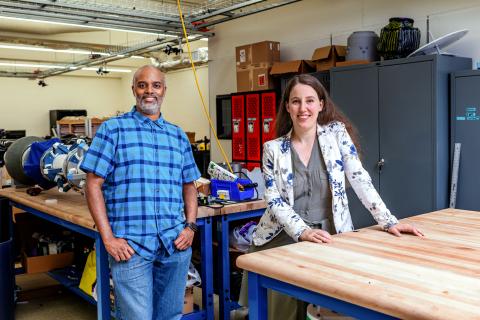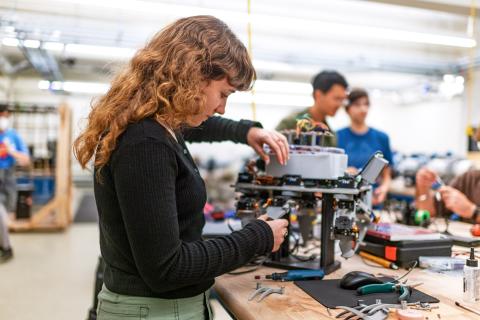An ecosystem of innovation
Inside a campus lab that thrives on interdisciplinary collaboration
Walk into the eighth-floor collaborative lab space in Case Western Reserve University’s Glennan Building, and the scene feels equal parts workshop and science fiction.
A modified vacuum sits on the floor, where its ability to sense and react to different environments is tested. Nearby, a large robotic worm lies on a table, ready to burrow through a landscape designed to mimic the resistance of soil. Across the room, a sandbox awaits the next trial for a crab-like robot, built to navigate uneven terrain with gripping legs.
The setup is still underway. But for Brian Taylor and Kathryn Daltorio, the space is already fostering a culture where expertise in other disciplines is only steps away.
CWRU engineering faculty and longtime friends—Taylor, PhD (CWRU’05; GRS’09,’12, mechanical engineering), and Daltorio, PhD (CWRU’05; GRS’07,’13, mechanical engineering)—share the 2,186-square-foot lab space with their teams of undergraduate and master’s degree students, doctoral candidates, postdocs and research associates, all focused on biorobotics.

When one of Daltorio’s students began attending lab meetings Taylor held, the two discovered overlapping research interests and began working together. When a student of Taylor’s needed to learn about soft robotics, he referred her to Daltorio’s class.
Taylor, an assistant professor in mechanical and aerospace engineering, studies animal navigation systems to inform robotics design. His research is inherently interdisciplinary, complementing the space’s collaborative nature.
Taylor describes the eighth-floor environment—with its offices and large shared space—as an “ecosystem” where spontaneous interactions thrive. “You can just walk across the floor and find someone who knows exactly how to help,” he said.
Daltorio, an associate professor of mechanical and aerospace engineering, focuses on bio-inspired robots—including worm-like burrowing robots and crab robots—to address real-world problems, such as finding and safely moving unexploded ordnance and other explosives that wash up on beaches. Having worked on this floor as a student and now a lead investigator, she’s energized by its growing culture of curiosity and collaboration. One student “might be working on something that I haven’t done in a year,” Daltorio explained. “But there’s another student who just did it last week, and they can help each other out.”

Lauren Biddlecombe, associate dean of strategic initiatives at Case School of Engineering, sees the biorobotics space as a test case for what’s to come in the university’s $300 million Interdisciplinary Science and Engineering Building being built nearby on the Case Quad. Opening next year, it is designed for researchers from different fields to work together.
“When faculty share space, traditional boundaries begin to dissolve, fostering collaboration that can lead to breakthroughs and new discoveries,” Biddlecombe said.
Photographs by Billy Delfs

